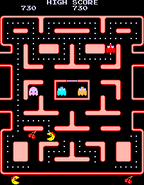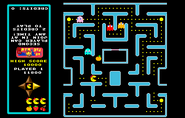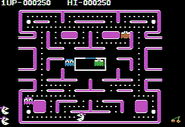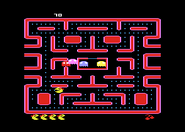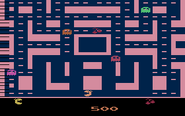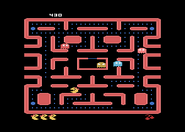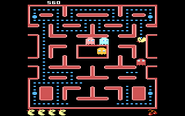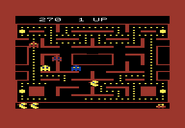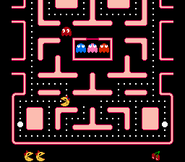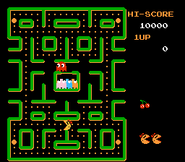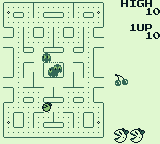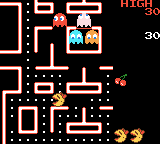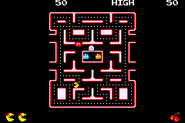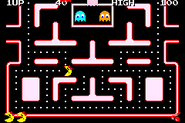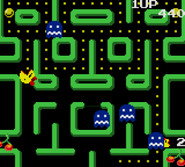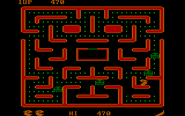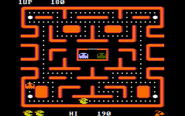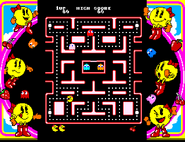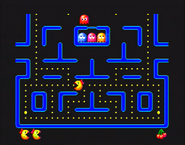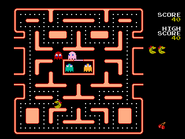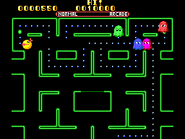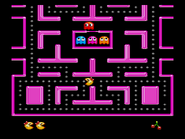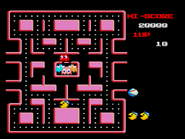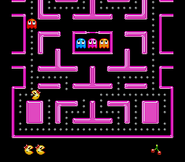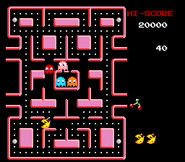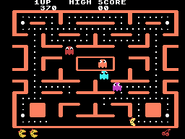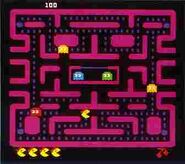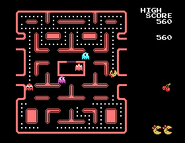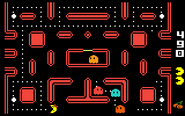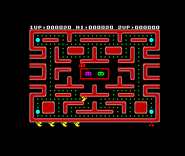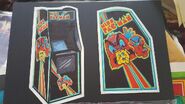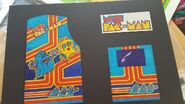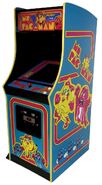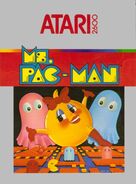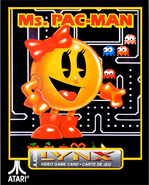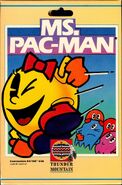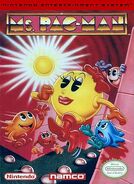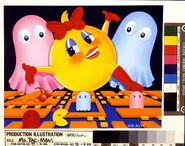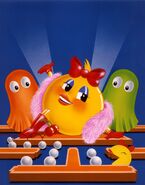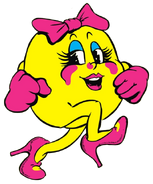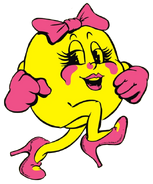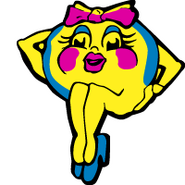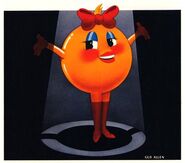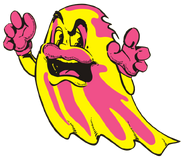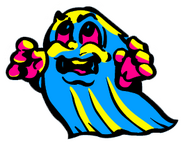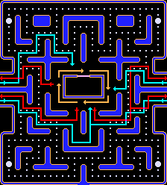- For other uses of Ms. Pac-Man, see Ms. Pac-Man (disambiguation).
Ms. Pac-Man (ミズパックマン Mizu Pakkuman) is a maze game in the Pac-Man series, acting as a direct sequel to Pac-Man. The game was developed by General Computer Corporation and was distributed in 1982 by Bally Midway.
It is the first Pac-Man video game to feature Ms. Pac-Man and the first Pac-Man video game to not be developed by Namco.
Gameplay[]
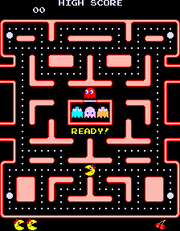
The beginning of the game's first round.
Ms. Pac-Man, like its predecessor, is a maze game where the player guides the titular Ms. Pac-Man through mazes to eat all the Dots within the maze. When Ms. Pac-Man eats all the dots within the maze, the round is completed and the player proceeds to the next round. Ghost monsters Blinky, Pinky and Inky return from the original Pac-Man alongside newcomer Sue (who chases Ms. Pac-Man just like Clyde, who is replaced in this game). If a ghost touches Ms. Pac-Man, one life is lost. The game ends when all extra lives are lost. Across the mazes are four flashing dots known as Energizers, which allows Ms. Pac-Man to gain the temporary ability to eat ghosts. Near the corners of the maze are four larger, flashing dots known as Energizers, provide Pac-Man with the temporary ability to eat the ghosts. The ghosts turn deep blue, reverse direction, and move slower when Pac-Man eats one. When a ghost is eaten, its eyes return to the ghost home where it is regenerated in its normal color. Blue ghosts flash white before they become dangerous again. In later rounds, the Energizer effects last for shorter time periods until they do not turn blue at all (they will simply reverse direction). Ms. Pac-Man will earn an extra life at 10,000 points (depending on the DIP switch settings for the machine, this can either be at 15,000 points, 20,000 points or no extra life at all).
Ms. Pac-Man makes several changes to the original Pac-Man, mostly breaking the original game's fixed cycle. Among the new changes in Ms. Pac-Man include the addition of cycling maze layouts. Upon completing the second round, the maze appearance will change appearance, adding more variable layouts to the game. There are four different mazes, each with their own color and maze layout. The player will start the game with a pink maze, while the light blue maze appears in round 3-5, the orange maze following through rounds 6-9 and the dark blue maze in rounds 10-13. After round 14, the game will cycle between the light blue and dark blue mazes after every fourth round, though the colors will occasionally alter.
Other notable changes affect the Ghosts and Fruit. The Ghosts in Ms. Pac-Man are more aggressive than the original, and no longer enter their scatter phases during gameplay; now always chasing Ms. Pac-Man. Beginning with the third round, they will also no longer slow down in any of the maze's Warp Tunnels, making it harder for Ms. Pac-Man to make distance from the monsters. The bonus fruit are now presented differently; instead of appearing beneath the ghost house for 8 seconds, they will now emerge from a Warp Tunnel and will bounce around the maze. The fruit will make two cycle paths beneath the Ghost House before it bounces towards a Warp Tunnel and disappears within. The fruit lineup is also reduced from eight to seven, also changing the foods to having them consistently be food-themed now. Returning from the original game is the Cherry, Strawberry, Orange and Apple, while three new foods; Pretzels, Pears and Bananas appear, replacing the Melons, Bells, Galaxians and Keys from the original game. Unlike the predecessor, the fruit now change after every round. Beginning with the eight round, the bonus fruits that appear are randomly decided (one orange and one banana can appear within a single round).
The intermissions (Coffee Breaks) that appear after certain rounds show Ms. Pac-Man and Pac-Man meeting and falling in love, and their developing relationship.
Changes to the original Pac-Man[]
- The game has four different colorful mazes that alternate. The orange maze appears in levels 1 and 2, the light blue maze appears in levels 3, 4, and 5, the brown maze appears in levels 6 through 9, and the dark blue maze appears in levels 10 through 13. Starting with level 14, the last two maze configurations alternate between each other every 4th level.
- The Fruits are now cherries, strawberries, oranges, pretzels, apples, pears, and bananas, respectively. After the banana appears, the fruit prizes are chosen at random.
- The fruit bounces around the screen instead of remaining stationary below the ghost house. It starts at one of the tunnel entrances and follows a hardcoded path to the ghost house where after doing one lap clockwise, it follows another hardcoded path to leave through another maze entrance.
- Each maze entrance has one entry and exit path. An exception is the third maze, where the right entrance weirdly has another rare entry path.[1]
- The intermissions have been changed to "Acts". The first one shows how Pac-Man and Ms. Pac-Man first meet, the second shows the two chasing each other around the screen, and the third shows Pac-Man and Ms. Pac-Man awaiting the arrival of Junior.
- The orange ghost (originally named "Clyde") is now named "Sue".
- The ghosts do not move in "scatter" and "chase" cycles as they did in the original game; Blinky and Pinky will move randomly and Inky and Sue will head for their "scatter" corners only during first behavior mode of a round. From there, while they will change direction occasionally, they will remain in constant attack.
- There are no longer any paths that the ghosts cannot travel through.
- Tunnels do not slow the ghosts down after Round 3.
Scoring System[]
- Pac-Dot - 10 points.
- Power Pellet - 50 points.
- Vulnerable Ghosts:
- #1 in succession - 200 points.
- #2 in succession - 400 points.
- #3 in succession - 800 points.
- #4 in succession - 1600 points.
- Fruit:
Development History[]
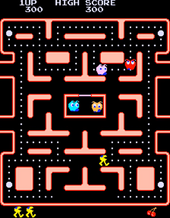
Screenshot from a fan-made hack, recreating Crazy Otto.
Originally, Ms. Pac-Man started as an unauthorized hack of Pac-Man called Crazy Otto by General Computer Corporation, featuring a Pac-Man-like character with a blue eye and legs. To avoid another lawsuit with Atari (which they had previously received for creating "Super Missile Attack", a Missile Command hack), G.C.C. presented the game to Bally Midway for approval of release. Midway, impatient for Namco to release the then-upcoming Super Pac-Man, purchased Crazy Otto for their own release.
After acquiring the game, Midway changed a quantity of details from Crazy Otto (some of which were at Namco founder Masaya Nakamura's request), going through several internal prototypes. The first of these was titled "Super Pac-Man" - unrelated to the Namco-developed game - which used the same character graphics as the original Pac-Man. Following this was "Pac-Woman", which starred a female Pac-Man with red hair. The Pac-Woman prototype was shown to Nakamura, who reportedly responded "Love the concept, get rid of the hair". After this, the final character design for Ms. Pac-Man was created. Another, lesser-known change is that, in Crazy Otto, the ghost's eyes did not appear after being eaten with a power pellet; this feature was added back in Ms. Pac-Man.
Ms. Pac-Man arcade machines were scheduled to enter production in quarter 4 of 1981. However, there was an internal conflict between whether the game should be titled "Miss", "Mrs.", or "Ms." Pac-Man; eventually, the latter was chosen. This delayed the release by several months, with production starting in February 1982 as opposed to '81. The game still says 1981 on the title screen, though this was changed to 1982 in some home console ports.
As Ms. Pac-Man (in its Crazy Otto form) was initially developed without Namco's permission, Bally Midway later turned the intellectual property rights to the game over to Namco. Ms. Pac-Man was never released in any arcade form in Japan, and would not receive a Japanese home console release until 1990 on the Atari Lynx.[2][3]
Home Ports[]
- Android
- Was released in two forms: a full paid version, and a free “lite” version. The Lite version used a “tokens” system which required the player to use 1 token in the event of a game over or if a level is completed. Tokens could be purchased with real money. The paid version of the game contained unlimited play and did not use any tokens.
- As part of a "Pac-Man Pink Ribbon Campaign" in October 2014, a special maze was added as a $0.99 (USD) download; all proceeds from the purchase would be donated to the National Breast Cancer Foundation.
- All the Ms. Pac-Man releases were delisted from the Google Play Store in July 2022.
- Apple II
- Arcade1UP Machines
- Many Arcade1UPs featuring Ms. Pac-Man have been released (see this page for full list).
- Atari 400/800/XL/XE
- Atari 2600
- Mazes are slightly different than the original.
- Atari 5200
- Atari 7800
- Atari Lynx
- Features a unique set of mazes not found in other versions.
- When playing in the "alternate" mazes mode, a lightning bolt can appear in the center of the screen; eating it will greatly increase Ms. Pac-Man's speed for a few seconds.
- A new intermission titled "Bus Stop" was added.
- This was the first official release of the game in Japan.
- Commodore 64
- Commodore VIC-20
- Famicom/NES
- Two versions were released:
- The first version, which was not licensed by Nintendo, was developed and published by Tengen in 1990.
- Tengen's port featured a scrolling maze camera with graphics that closely resemble the arcade original. In addition to the general game options, the port added various new features such as different maze layouts, simultaneous two-player gameplay, a booster effect, game difficulties, and adds an ending after Level 32.
- The second version, which was licensed by Nintendo, was developed by Now Production and published by Namco Hometek in 1993.
- This version has a single screen layout, has different maze colors, and plays slower in comparison to the original game. The game additionally features a Hard mode toggle.
- While lacking the maze selection modes compared to the Tengen port, there are a few mazes exclusive to the 1993 port, which appear after several rounds of the "original" maze layouts are completed.
- This version of the game is considered by many outlets to be inferior to Tengen's own port.
- This version has re-appeared in several officially licensed plug-and-play systems and portable players released in the 2010s.
- The first version, which was not licensed by Nintendo, was developed and published by Tengen in 1990.
- Two versions were released:
- Game Boy
- Features two additional maze layouts not seen in the original arcade game.
- For unknown reasons, every cutscene plays the music from "They Meet".
- Game Boy Color
- Released as Ms. Pac-Man: Special Color Edition, which also included Super Pac-Man.
- Same port as the original Game Boy version, only colorized. The sounds in this port were altered.
- Game Boy Advance
- Two versions were released, which were included in Namco Museum and Namco Museum 50th Anniversary. A recreation is used in the former based on the Namco Museum Vol. 3 port, whilst the latter appears to use actual emulation (albeit loosely).
- GameCube
- Three versions were released. The game was included in Namco Museum and Namco Museum 50th Anniversary, and was featured as a bonus game in Pac-Man World 2. The ports featured in Namco Museum and Pac-Man World 2 are based on the Namco Museum Vol. 3 port.
- Game Gear
- Features six additional maze layouts not seen in the original arcade game; two of these are also seen in the Game Boy port. The "new" mazes appear beginning on level 9, and precede intermission breaks.
- Features different colors for the mazes compared to the original.
- Handheld LCD Games
- Many different handheld LCD games have been released, the earliest being the Orlitronic "shaped" handheld from 1984.
- The ports included greatly vary between units. The majority of earlier systems took creative liberties when porting the game, and feature many differences when compared to the original. Later consoles (such as the MGA "Classic Arcade" version) are much more accurate conversions.
- Most Ms. Pac-Man LCD games are in black-and-white, but a handful were in color.
- IBM PC
- Supports CGA composite mode for additional colors.[4]
- iOS (iPhone, iPad and iPod Touch)
- Was released in two forms: a full paid version, and a free “lite” version. The Lite version used a “tokens” system which required the player to use 1 token in the event of a game over or if a level is completed. Tokens could be purchased with real money. The paid version of the game contained unlimited play and did not use any tokens.
- The iPad version of the games was released separately from the iPhone and iPod Touch versions of the game as an "HD" version.
- As part of a "Pac-Man Pink Ribbon Campaign" in October 2014, a special maze was added as a $0.99 (USD) download; all proceeds from the purchase would be donated to the National Breast Cancer Foundation.
- All the Ms. Pac-Man releases were delisted from the App Store in July 2022.
- iPod Classic
- Mobile
- Nintendo 64
- Two identical versions were released, which were included in Namco Museum 64 and Ms. Pac-Man Maze Madness. Both ports are based on the Namco Museum Vol. 3 port.
- Phillips CD-i
- Included in Arcade Classics.
- Similar to the Tengen releases, featuring many options and a two-player cooperative mode, in addition to many new mazes (which are exclusive to this release).
- Features different colors for the mazes than the original game.
- PlayStation
- Two identical versions were released, which were included in Namco Museum Vol. 3 and Ms. Pac-Man Maze Madness.
- PlayStation 2
- Three versions were released. The game was included in Namco Museum and Namco Museum 50th Anniversary, and was featured as a bonus game in Pac-Man World 2. The versions featured in Namco Museum and Pac-Man World 2 are based on the Namco Museum Vol. 3 port.
- PlayStation 3
- The game was released as paid DLC for Pac-Man Museum, but was also playable through Namco Museum Vol. 3 and Ms. Pac-Man Maze Madness via the PS one Classics line of downloadable titles.
- PlayStation 4
- Released as a standalone digital release titled Arcade Game Series: Ms. Pac-Man.
- PlayStation Portable
- The game was included in Namco Museum Battle Collection (Namco Museum 1 in Japan), but was excluded in the Korean release. The game was also playable through Namco Museum Vol. 3 and Ms. Pac-Man Maze Madness via the PS one Classics line of downloadable titles.
- PlayStation Vita
- The game was playable through Namco Museum Vol. 3 and Ms. Pac-Man Maze Madness via the PS one Classics line of downloadable titles.
- Plug & Play TV Games
- Many different Plug & Plays featuring Ms. Pac-Man have been released (see this page for full list), the earliest being Ms. Pac-Man Collection from 2004.
- The original systems were released by Jakks Pacific, and featured a port very close to the arcade version. Consoles from the 2010s onward were from different manufacturers, and often feature the Namco 1993 NES version.
- Pocket Player (My Arcade)
- Included in the Ms. Pac-Man Pocket Player; uses the Namco 1993 NES version.
- Sega Master System
- Features all modes and options from the Tengen 1990 NES version, in addition to overhauled graphics.
- Features different colors for the mazes than the original game.
- Sega Genesis/Mega Drive
- Two versions were released. The first was a single-cartridge version, which features all modes and options from the Tengen 1990 NES version, in addition to overhauled graphics. A different port was later included as a bonus game in Pac-Man 2: The New Adventures; here it was rebranded as Pac-Jr., a modified version of Ms. Pac-Man that changes the mazes and stars Jr. Pac-Man.
- Pac-Jr. is similar to the Namco 1993 NES version of Ms. Pac-Man, but features slightly updated graphics and a high-score table.
- Two versions were released. The first was a single-cartridge version, which features all modes and options from the Tengen 1990 NES version, in addition to overhauled graphics. A different port was later included as a bonus game in Pac-Man 2: The New Adventures; here it was rebranded as Pac-Jr., a modified version of Ms. Pac-Man that changes the mazes and stars Jr. Pac-Man.
- Sega Genesis clone hardware
- Several newer Ms. Pac-Man handheld releases (from the early 2020s onward) feature an original port of the game running on "Firecore" Genesis clone hardware. This port was likely made by Shiru, who produced a similar Pac-Man port several years earlier, and has a Ms. Pac-Man Genesis conversion listed on his website.[5]
- Known consoles featuring the port (e.g. the Ms. Pac-Man Micro Player Pro and Pocket Player Pro) has the screen rotated on its side, creating an arcade-perfect pixel layout. In the Pac-Man port, there are two additional horizontal video modes in its coding; it is currently unknown if this also applies to Ms. Pac-Man.
- Sega Dreamcast
- Two identical versions were released, which were included in Namco Museum and Ms. Pac-Man Maze Madness. Both versions are based on the Namco Museum Vol. 3 port.
- Super Famicom/SNES
- Two versions were released. Ms. Pac-Man was included as a bonus game in Pac-Man 2: The New Adventures; unlike the Genesis port, it does not change any aspects of the original. A different port on a standalone cartridge was released in 1996, which is nearly identical to the Sega Genesis/Mega Drive port.
- The Pac-Man 2 version is similar to the Namco 1993 NES version, but features slightly updated graphics and a high-score table.
- Two versions were released. Ms. Pac-Man was included as a bonus game in Pac-Man 2: The New Adventures; unlike the Genesis port, it does not change any aspects of the original. A different port on a standalone cartridge was released in 1996, which is nearly identical to the Sega Genesis/Mega Drive port.
- Tabletop Arcade Machines
- Many different tabletop arcade machines have been released, the earliest being the Coleco Tabletop from 1983.
- Following the Coleco Tabletop, no other tabletops were released up until the late 2010s. More recent consoles often either feature the Namco 1993 NES version (ex: Ms. Pac-Man Micro Player) or use a custom port loosely resembling the arcade version (ex: Arcade Classics - Ms. Pac-Man).
- TI-99/4A
- Wii U
- Available in the Virtual Console release of Namco Museum (Game Boy Advance).
- Windows PC
- Numerous conversions of Ms. Pac-Man were released for Windows platforms, from Windows 95 to Windows 10. The earliest of these were included in Microsoft Revenge of Arcade and Namco History Vol. 3, both from 1998. A standalone digital version titled Arcade Game Series: Ms. Pac-Man was also released.
- Due to the more powerful architecture of computers compared to consoles at the time, all ports were straight emulations of the arcade version, with little to no differences (the only exception being the bonus version included in Pac-Man World 2).
- Xbox
- Four versions were released. A single-disc version was released, often referred to as the Xbox Live Arcade Disc (although the cover just says "Arcade"), which was intended to be a demo for the Xbox Live service. The game was included in Namco Museum and Namco Museum 50th Anniversary, and was featured as a bonus game in Pac-Man World 2. The versions featured in Namco Museum, the Xbox Live release and Pac-Man World 2 are based on the Namco Museum Vol. 3 port.
- Xbox 360
- Three versions were released. The game was released as a standalone digital release through the Xbox Live service. It was also included in Namco Museum Virtual Arcade (in which it is the same as the Xbox Live version). It was later released as paid DLC for Pac-Man Museum.
- A "picture pack" for the Xbox 360 (acting as profile pictures for Xbox Live) was released alongside the Xbox 360 Ms. Pac-Man port.
- Xbox One
- Released as a standalone digital release titled Arcade Game Series: Ms. Pac-Man.
- ZX Spectrum
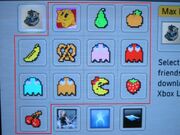
Picture Pack
A handful of Ms. Pac-Man ports by Atarisoft to other systems were planned, but were never released. These include the ColecoVision, Intellivision, BBC Micro, and IBM PCjr.[6]
Several homebrew versions of Ms. Pac-Man have also been released for consoles such as the ColecoVision and Intellivision.
Other versions[]
There are many variations of Ms. Pac-Man that are fundamentally the same as the original game, but feature several differences that make them stand out. These games include:
- Ms. Pac-Man Plus
- Ms. Pac-Man (speed-up chip)
- Ms. Pac-Man (Tengen)
- Pac-Jr.
- Ms. Pac-Man (Galaxy Games StarPak 2)
- Ms. Pac-Man for Prizes
Namco Museum Vol. 3 port[]
Similarly to Pac-Man, Ms. Pac-Man also saw a Namco Museum port in 1996 through Namco Museum Vol. 3. This version, like Pac-Man, used the source code from the original game and was perhaps the most frequently ported version for quite some time. Some things about it were changed however, and this version sees all of the applicable changes Pac-Man had, plus:
- Blinky and Pinky do not move randomly during the first behavior mode; they head to their original "scatter" corners as they did in Pac-Man.
- Furthermore, the "scatter" and "chase" cycles are restored in the game.
- The tunnel slowdown effect does not occur until a ghost reaches middle of the tunnel (in the original game, they are slowed down at the entrance).
- The tunnel slowdown occurs in all rounds.
- Most of the sound samples have their pitch raised.
- The background sound effect does not change as the player gets closer to finishing the maze.
Play Online[]
These versions of Ms. Pac-Man are either listed in the public domain or are considered abandonware. Clicking the game title will lead you to a playable online version of it from archive.org (mobile compatibility may vary).
- Recommended: Super ABC (Pac-Man multigame kit) (Arcade, 1999)
- Recommended: Ms. Pac PC (MS-DOS, 1995)
- Recommended: Champ Ms. Pac-em (MS-DOS, 1996)
- Ms. Chomp (Windows 3.1, 1992)
- Ms. Pac-Man (Atari 400/800/XL/XE, 1983)
- Ms. Pac-Man (Coleco) (Tabletop Arcade Machine, 1983)
- Pac-Man Collection (ColecoVision, 2008)
- Ms. Pac-Man (Game Gear, 1993)
- Ms. Pac-Man (IBM PC, 1983)
- Ms. Pac-Man (Sega Master System, 1990)
Trivia[]
- Starting in 2008 after a court case, General Computer Corporation began to receive expensive royalties from Namco for most Ms. Pac-Man re-releases, including "coin-operated" arcade machines and home console/mobile ports. This has led to (Bandai) Namco no longer utilizing the Ms. Pac-Man game and IP very often; however, some game re-releases occur through various loopholes with the agreement.
- For further information on this subject, see History of Ms. Pac-Man legal issues.
- This is the first Pac-Man game not to be developed by Namco.
- Toru Iwatani is not known to have publicly commented on Ms. Pac-Man, despite questions from reporters.[7]
- If a coin is inserted directly as the machine boots up and starts attract mode, the light pink in the first maze will change to blue - presumably as some sort of glitch. The blue will change back to the proper pink color if the player either loses a life or completes the level.
- In the game's prototype stages, Ms. Pac-Man had long red hair and a yellow bow, which was eventually changed to the iconic red bow with only a tiny tuft of hair. This may have been a last-minute change, as it carried over into the cartoon series.
- The Nintendo GameCube version of Pac-Man World 2 includes Ms. Pac-Man as a bonus game; however, this version features an odd bug, where the mazes all use the same color scheme as each other. This does not apply to the PlayStation 2 and Xbox versions of the game.
- Blinky and Pinky moving randomly at the start of each round is achieved by them being programmed to randomly target each of the original four "scatter" corners of the maze.
- The Super NES version of Pac-Man 2: The New Adventures feature Ms. Pac-Man as an unlockable game; however, the Genesis version features Pac-Jr., a modified version of the game with Jr. Pac-Man as the main character. It is assumed to have been done to avoid confusion with Tengen's Ms. Pac-Man for the Sega Genesis, which released 3 years prior.
- A Super Nintendo Entertainment System version of Tengen's Ms. Pac-Man was released by Williams Entertainment in 1996, 2 years after the release of Pac-Man 2: The New Adventures.
- The original print runs of Ms. Pac-Man machines had the side artwork (and the artwork below the coin door) entirely colored in blue, yellow, and pink. Later production cabinets added white to the characters, as well as coloring in Ms. Pac-Man's eyeshadow and turning the multi-colored ghost into Blinky. These later-run machines are rather hard to come by, with the earlier model being much more common.
- This is the first Pac-Man game to have two female ghosts (being Pinky and Sue).
- An Atari 2600 commercial of Ms. Pac-Man that aired in Australia incorrectly states Ms. Pac-Man is Pac-Man's older sister, when she is supposed to be Pac-Man's wife.[8]
Gallery[]
Screenshots[]
Concept Artwork[]
Machine and Box Art[]
Character Artwork[]
Hardcoded Fruit Paths[]
External links[]
- From Crazy Otto to Ms. Pac-Man - for information on the many prototype versions of the game
References[]
- ↑ https://www.youtube.com/watch?v=mmRPvbeYSPQ The second fruit path in the right exit of Ms. Pac-Man's third maze.
- ↑ http://tk-nz.game.coocan.jp/gamedatabase/software/DB_ATM_LX1989-1991.html
- ↑ https://stat.ameba.jp/user_images/20190802/22/ponyponyex/b0/91/j/o0962130014520398913.jpg
- ↑ https://www.mobygames.com/attribute/sheet/attributeId,29/p,4/
- ↑ "Ms. Pac-Man - Genesis, ??? - an authentic arcade port for another commercial toy" https://shiru.untergrund.net/aboutme.shtml#gamedev
- ↑ http://www.digitpress.com/faq/atarisoft.htm
- ↑ https://www.fastcompany.com/3067296/the-mit-dropouts-who-created-ms-pac-man-a-35th-anniversary-oral-history
- ↑ https://youtu.be/Gp1CKap2v28

